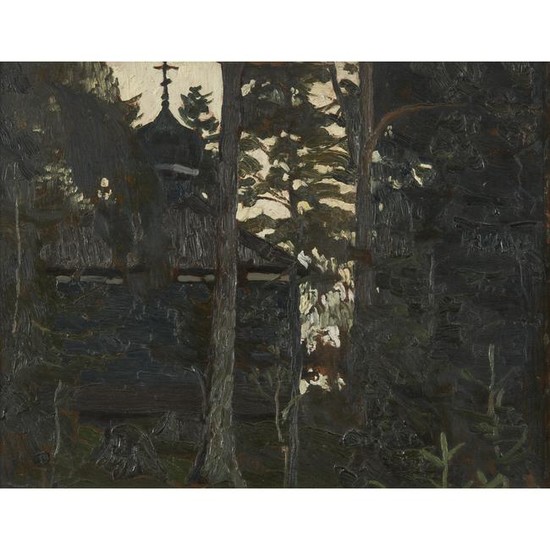Nikolai Konstantinovich Roerich (Russian, 1874–1947)
Nikolai Konstantinovich Roerich (Russian, 1874–1947)
Old Chapel in Valdai County
Titled [in Cyrillic] "Watchtower in Pskov" on original Louisiana Purchase Exposition label verso, oil on panel
12 x 16 in. (30.5 x 40.6cm)
Executed in 1903.
PROVENANCE:
Private Collection, California.
EXHBITED:
"The Louisiana Purchase Exposition" (also known as the "Saint Louis World's Fair"), Saint Louis, Missouri, April 30-December 1, 1904, no. 65 (per original label verso).
NOTE:
Nicholas Roerich is a towering figure in Russian painting of the late 19th and early 20th centuries. During his storied career, he was also an archaeologist, poet, lawyer, and philosopher who widely travelled-living in his native Russia, Finland, England, India, and America. He also achieved fame as a theater set designer, was a devout follower of mysticism, and was an ardent advocate for the preservation of cultural heritage, objects, institutions, and monuments. Begun as a private initiative, he is credited with developing proposals establishing what became known as the 'Roerich Pact:' an inter-American treaty signed into law in 1935 to protect cultural property in times of war.
Born in St. Petersburg, Russia to an upper middle class family, Roerich showed an early aptitude for drawing and enrolled in the Imperial Academy of Arts in 1893. He later directed the Imperial Society for the Encouragement of the Arts. Considered a Russian Symbolist, he studied with the landscape painter Arkhip Kuindzhi. Said to have executed over seven thousand works during his lifetime, he was inspired by "historic sources: folklore, legends, and ancient monuments. But greater emphasis is placed by him on intuition and the penetration into the spirit of the Past" (M.S. Nanjunda Rao, Nicolas Roerich, New Delhi, 1992). In Russia, Roerich completed monumental paintings, church mosaics and frescoes. In 1903, when the present work was painted, Roerich and his wife Helena embarked on a forty city tour of ancient Russian cities.
As noted in Nicholas Roerich, A Quest & A Legacy (Manju Kak, ed., New Delhi, 2013, pp. 11-12), the artist's work may be divided into three periods: his Russian period, his Theatrical Phase, and his Mountain Phase, the third following his arrival in Bombay in 1923. The present work was likely painted during the first of these phases and is part of a series of nearly seventy works referred to as the 'Architectural Studies' from his travels though old Russian towns. As Kak notes, "The deep patriotic-nationalistic roots of Roerich led to his search for Russia's pagan beginnings and folklore and they were the subject of his earlier paintings" (Kak, op. cit., pp. 192).
Painted with rich applications of dark-toned impasto, the present work depicts an old chapel, its cupola apparently adorned with a cross, framed by the surrounding forest, invoking a spiritual, mystical ambience. Dimensions:
Sale price
Estimate
Time, Location
Auction House
Nikolai Konstantinovich Roerich (Russian, 1874–1947)
Old Chapel in Valdai County
Titled [in Cyrillic] "Watchtower in Pskov" on original Louisiana Purchase Exposition label verso, oil on panel
12 x 16 in. (30.5 x 40.6cm)
Executed in 1903.
PROVENANCE:
Private Collection, California.
EXHBITED:
"The Louisiana Purchase Exposition" (also known as the "Saint Louis World's Fair"), Saint Louis, Missouri, April 30-December 1, 1904, no. 65 (per original label verso).
NOTE:
Nicholas Roerich is a towering figure in Russian painting of the late 19th and early 20th centuries. During his storied career, he was also an archaeologist, poet, lawyer, and philosopher who widely travelled-living in his native Russia, Finland, England, India, and America. He also achieved fame as a theater set designer, was a devout follower of mysticism, and was an ardent advocate for the preservation of cultural heritage, objects, institutions, and monuments. Begun as a private initiative, he is credited with developing proposals establishing what became known as the 'Roerich Pact:' an inter-American treaty signed into law in 1935 to protect cultural property in times of war.
Born in St. Petersburg, Russia to an upper middle class family, Roerich showed an early aptitude for drawing and enrolled in the Imperial Academy of Arts in 1893. He later directed the Imperial Society for the Encouragement of the Arts. Considered a Russian Symbolist, he studied with the landscape painter Arkhip Kuindzhi. Said to have executed over seven thousand works during his lifetime, he was inspired by "historic sources: folklore, legends, and ancient monuments. But greater emphasis is placed by him on intuition and the penetration into the spirit of the Past" (M.S. Nanjunda Rao, Nicolas Roerich, New Delhi, 1992). In Russia, Roerich completed monumental paintings, church mosaics and frescoes. In 1903, when the present work was painted, Roerich and his wife Helena embarked on a forty city tour of ancient Russian cities.
As noted in Nicholas Roerich, A Quest & A Legacy (Manju Kak, ed., New Delhi, 2013, pp. 11-12), the artist's work may be divided into three periods: his Russian period, his Theatrical Phase, and his Mountain Phase, the third following his arrival in Bombay in 1923. The present work was likely painted during the first of these phases and is part of a series of nearly seventy works referred to as the 'Architectural Studies' from his travels though old Russian towns. As Kak notes, "The deep patriotic-nationalistic roots of Roerich led to his search for Russia's pagan beginnings and folklore and they were the subject of his earlier paintings" (Kak, op. cit., pp. 192).
Painted with rich applications of dark-toned impasto, the present work depicts an old chapel, its cupola apparently adorned with a cross, framed by the surrounding forest, invoking a spiritual, mystical ambience. Dimensions:



